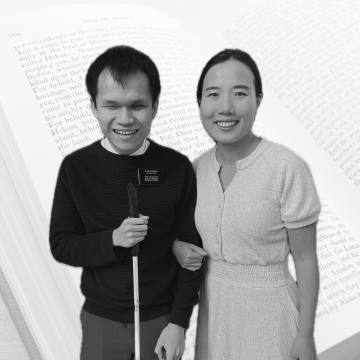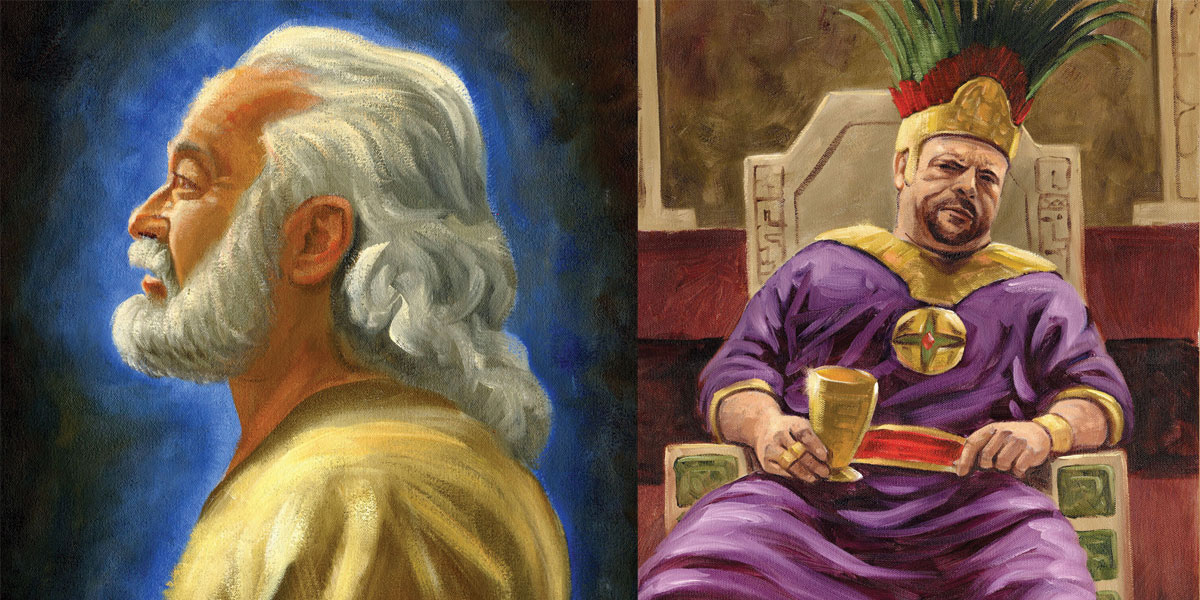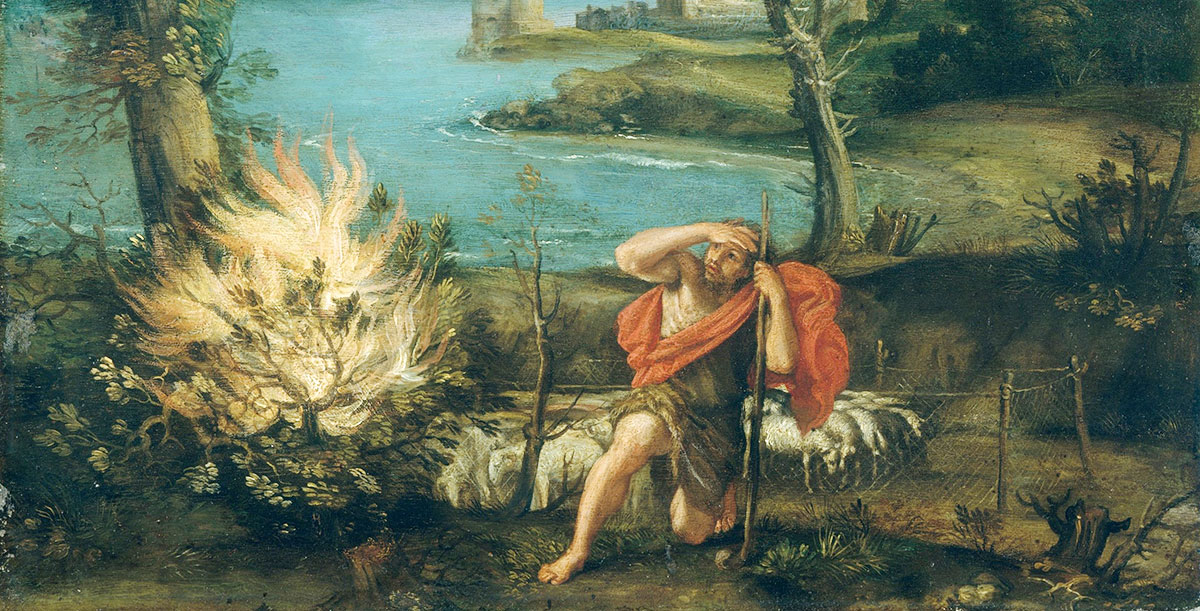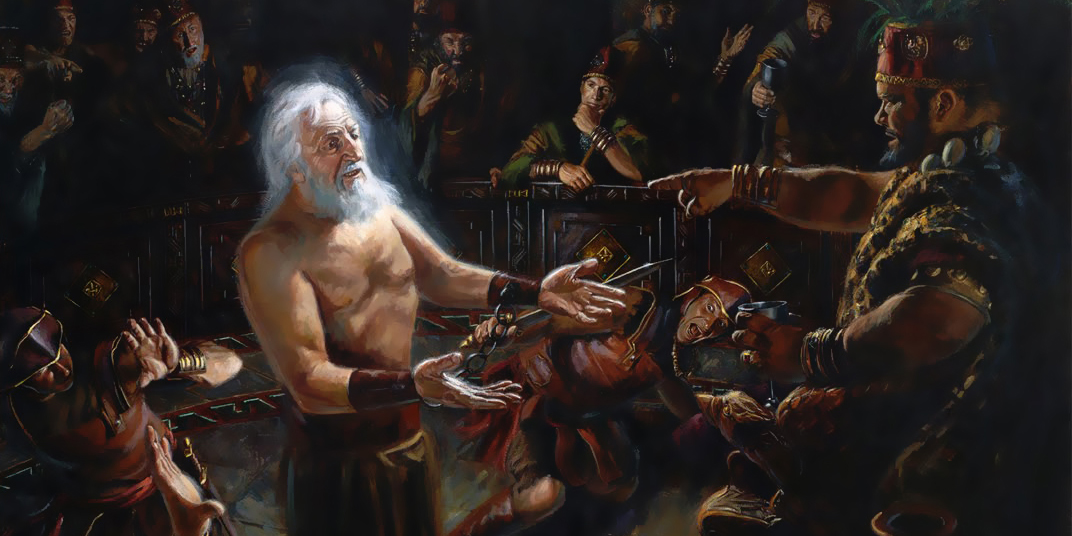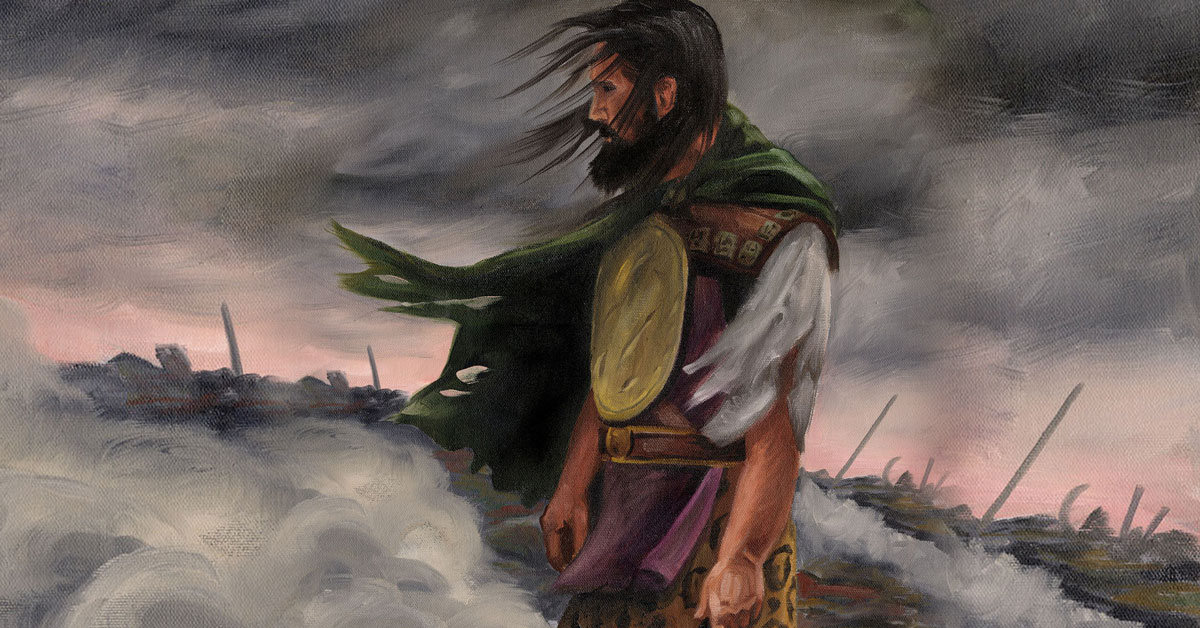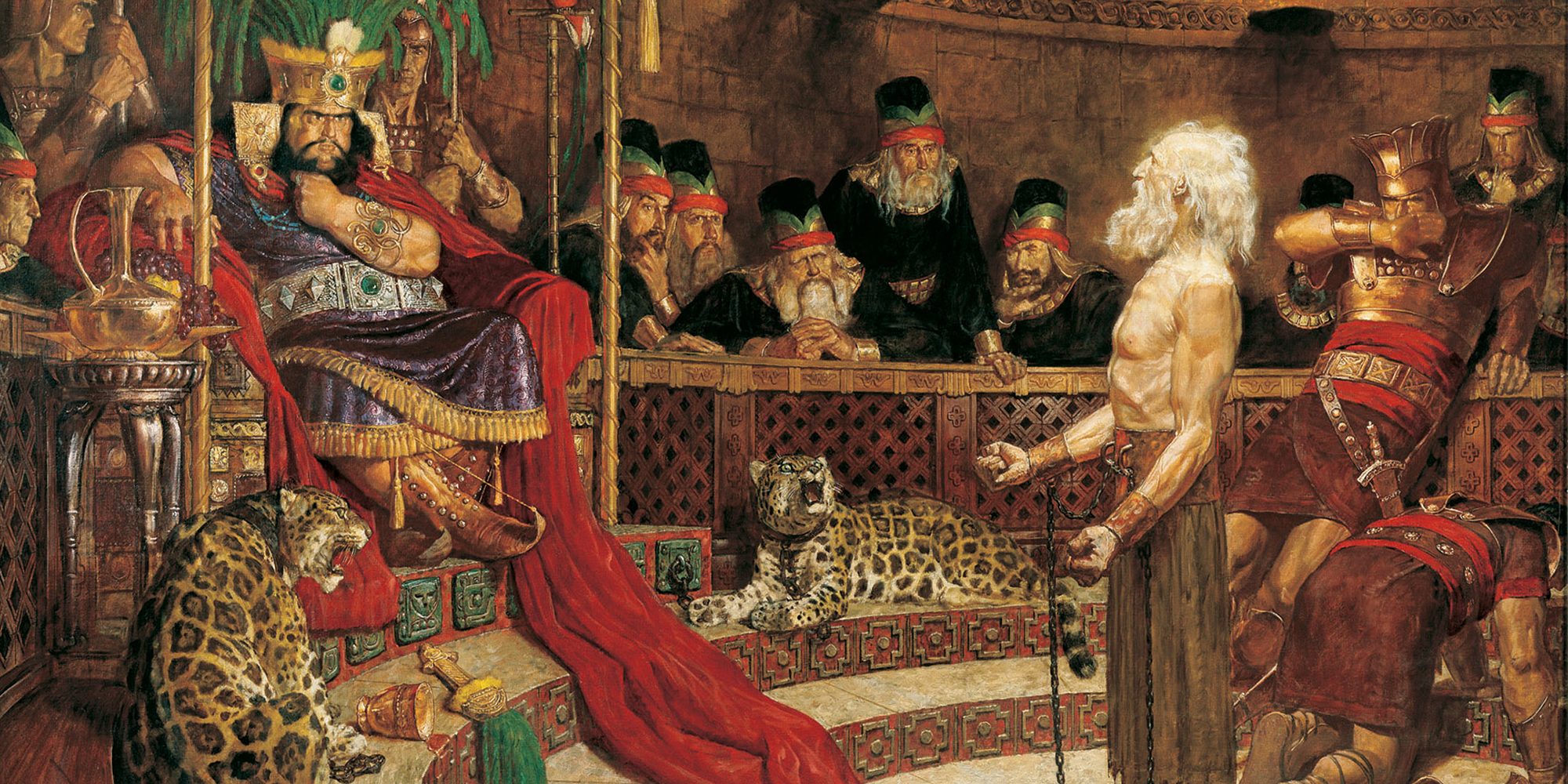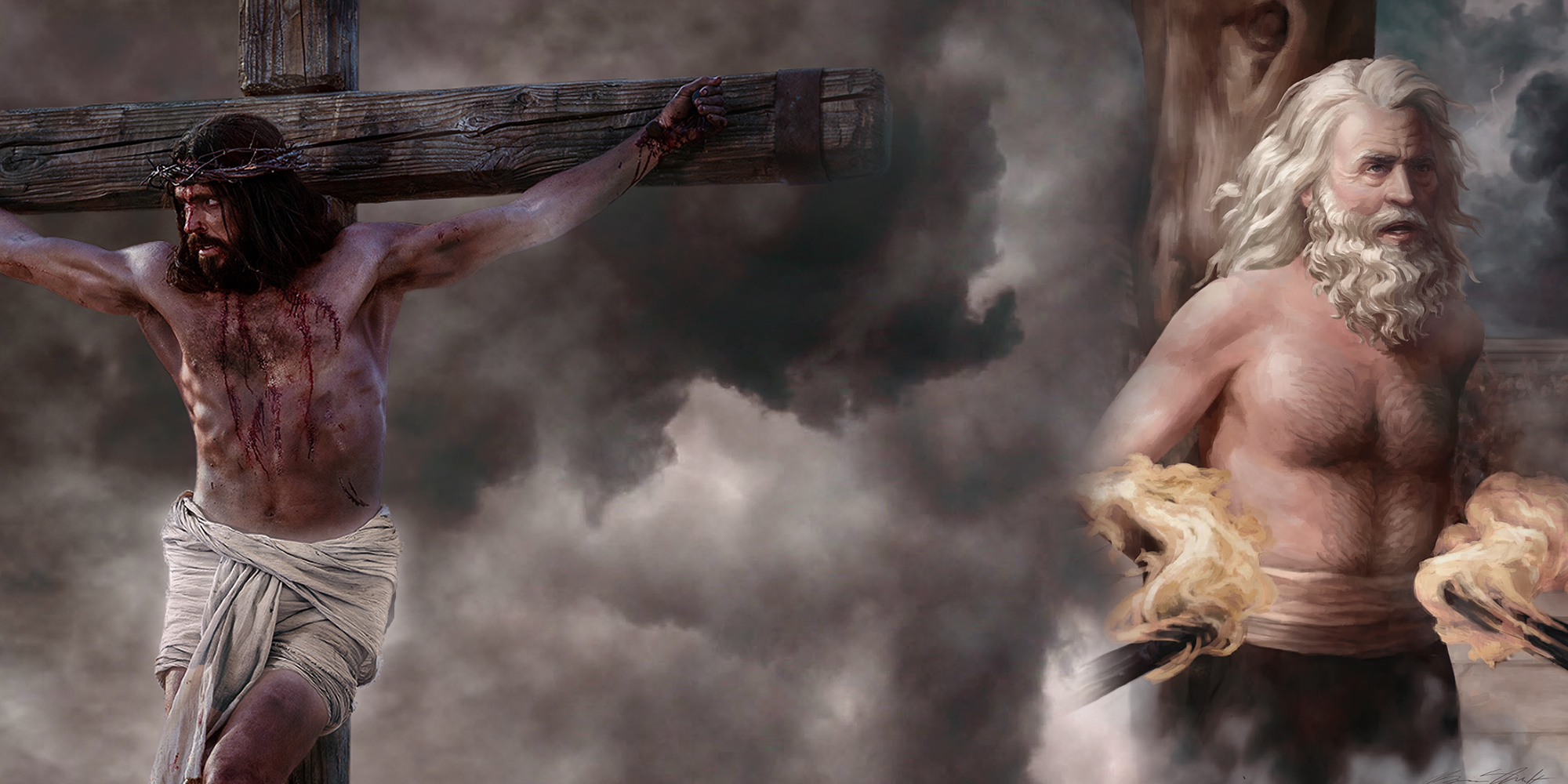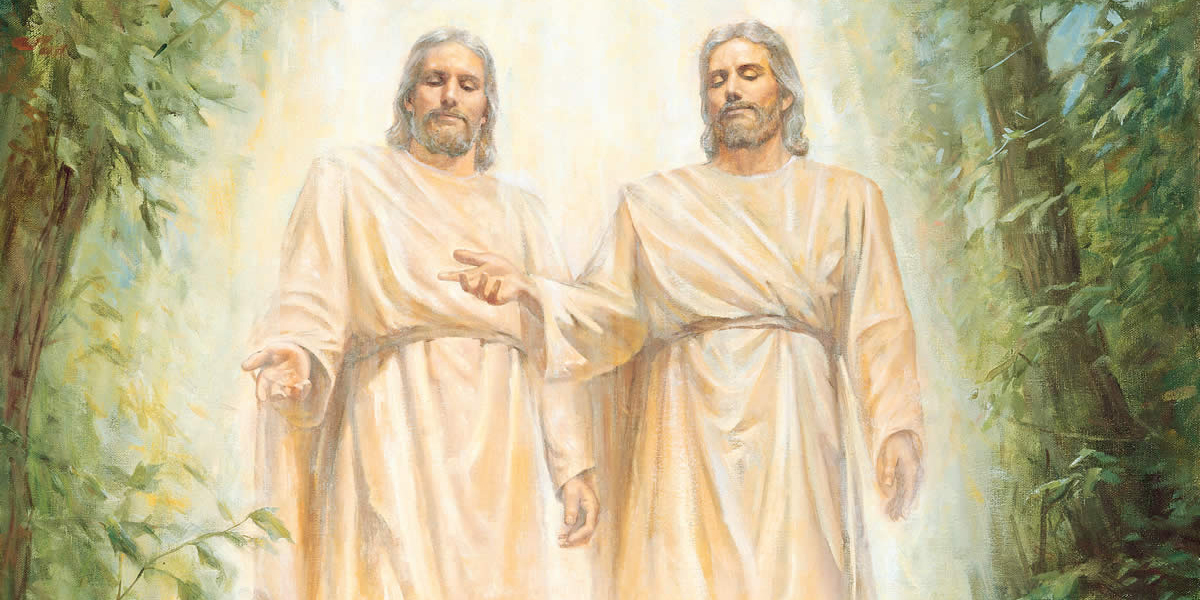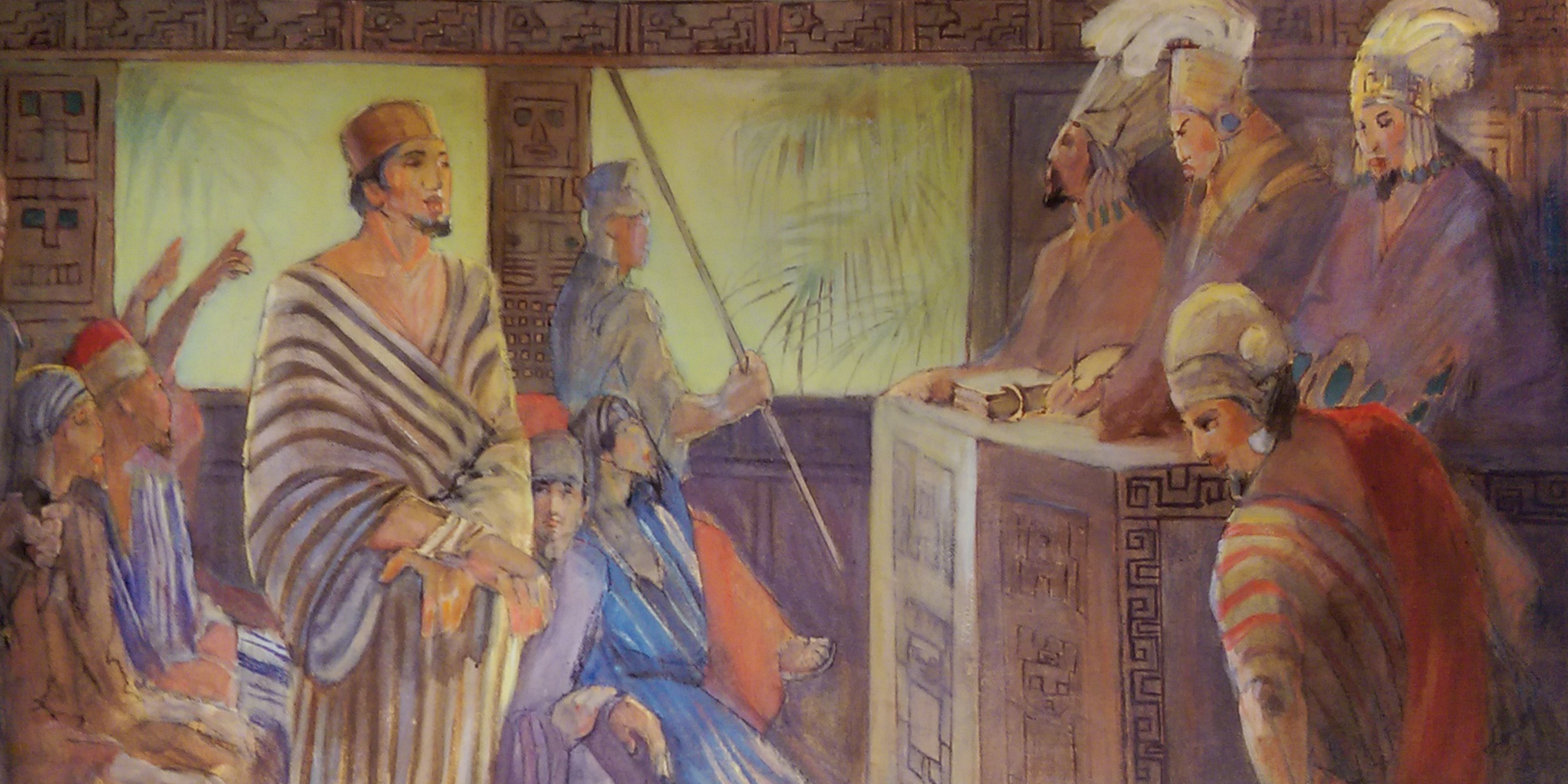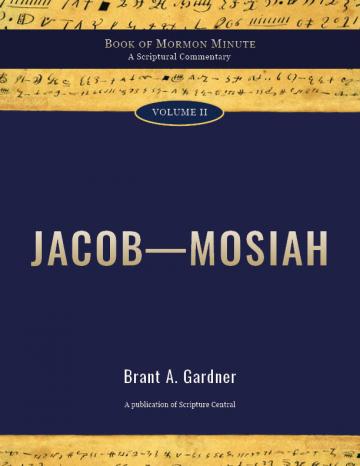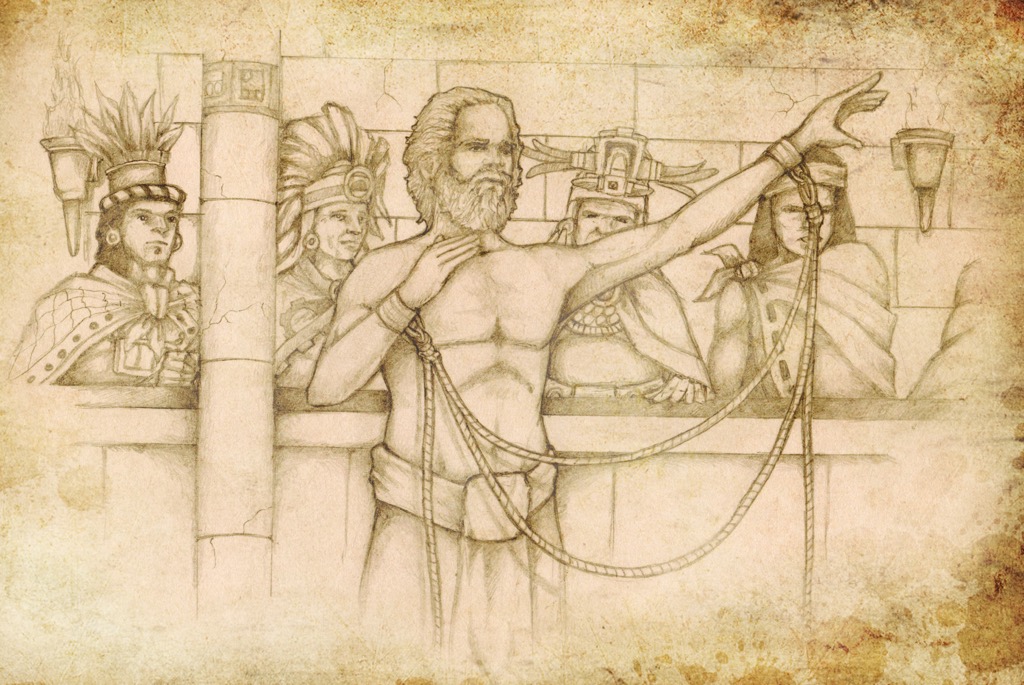You are here
Book of Mormon Central is in the process of migrating to our new Scripture Central website.
We ask for your patience during this transition. Over the coming weeks, all pages of bookofmormoncentral.org will be redirected to their corresponding page on scripturecentral.org, resulting in minimal disruption.

Mosiah 11–17
Scripture Central Videos
Watch videos from Gospel scholars and teachers to learn more about these Book of Mormon passages.
Other Creator Videos
KnoWhys
Evidences
Commentary
Book of Mormon Minute is a commentary series made especially for the free ScripturePlus app, which features insights from Book of Mormon scholar Brant A. Gardner. John W. Welch's notes for Come, Follow Me are also available for free.
John W. Welch, General Editor
Reading Plan
Structure your personal scripture study by following a 15-minute, day-by-day plan. Each day's assignment includes the required scripture passages from the Come, Follow Me curriculum, as well as suggestions for additional resources to bring context and understanding to your study. For the best experience, use our Reading Plan in the free ScripturePlus app! You can track your progress and have access to the best resources.
Monday
- Scripture: Mosiah 11:1–29
- Commentary: Mosiah 11:20-22
-
Additional Study
- Evidence: Exodus Reversal and King Noah’s People
- Commentary: Mosiah 11:23-25
- Commentary: Noah Had Many Wives and Concubines
- Commentary: King Noah Imposed a Tax on His People
- Evidence: Wordplay on Noah
- KnoWhy: Why Does the Book of Mormon Mention Wine, Vineyards, and Wine-presses?
Tuesday
- Scripture: Mosiah 12:1–37
- Commentary: The Priests Questioned Abinadi
-
Additional Study
- KnoWhy: What Does It Mean to “Apply Your Heart to Understanding”?
- Commentary: The Priests of Noah Claim to Keep the Law of Moses
- Commentary: Mosiah 12:6-7
- Commentary: Mosiah 12:13-16
- Commentary: Mosiah 12:17-19
- Commentary: Mosiah 12:20-24
- KnoWhy: Why Would Noah’s Priests Quiz Abinadi on Isaiah?
- KnoWhy: Why Did Abinadi Warn the People of an East Wind?
Wednesday
- Scripture: Mosiah 13:1–35
- Commentary: Mosiah 13:32-35
- Additional Study
Thursday
- Scripture: Mosiah 14:1–12
- Commentary: Mosiah 14:3-6
- KnoWhy: Why Did Abinadi Talk About the Suffering Messiah?
-
Additional Study
- Commentary: Mosiah 14:7-12
- Evidence: Quoting Long Passages of Scripture
Friday
- Scripture: Mosiah 15:1–31
- Commentary: Christ Will Be Led as a Sheep before the Shearer
-
Additional Study
- KnoWhy: Why Does Abinadi Use the Phrase "the Bands of Death"?
- Commentary: The Ancient Perspective on Monotheism
- Commentary: The Significance of the Lord Making His Holy Arm Bare
- Commentary: Mosiah 15:8-10
- Commentary: Mosiah 15:11-13
- Commentary: Mosiah 15:20-25
- Commentary: Mosiah 15:26-27
- KnoWhy: How is Christ Both the Father and the Son?
Saturday
- Scripture: Mosiah 16:1–15
- Video: Book of Mormon Evidence: Prophetic Perfect
- Commentary: Why Did Abinadi Speak in the Past Tense?
-
Additional Study
- Evidence: Swallowed Up in Netzach
- Commentary: The Sting of Death is Swallowed Up in Christ
- Commentary: Mosiah 16:4-5
- Commentary: Mosiah 16:9-12
- Commentary: Mosiah 16:13-15
- KnoWhy: Why Did Book of Mormon Prophets Speak of Future Events as if They Had Already Happened?
- KnoWhy: Why Did Abinadi Stretch Forth His Hand as He Prophesied?
Sunday
- Scripture: Mosiah 17:1–20
- Commentary: King Noah and His Priests Discuss How to Respond Next
-
Additional Study
- Evidence: Scourged with Faggots
- Commentary: Mosiah 17:1-4
- Commentary: Mosiah 17:5-8
- Commentary: Mosiah 17:9-12
- Commentary: Mosiah 17:13-15
- Commentary: The Conviction and Execution of Abinadi
- Evidence: Abinadi’s Trial
Additional Resources
Explore art, charts, and more.
Images
Charts
- Life Spans of Mosiah's Lineage
- Flashbacks in the Book of Mosiah
- Nephite and Lamanite Kings
- Consistent Elements in Nephite Declarations of Faith
- Key Doctrinal Chapters: Mosiah–Alma
- Isaiah Passages Listed by Book of Mormon Reference
- Isaiah Passages Listed by Isaiah Reference
- Outlines of Passages Quoting Isaiah
- Missionary Work
- Legal Cases and Procedures in the Book of Mormon
- Legal Charges Brought against Abinadi
- Did Abinadi Prophesy against King Noah on Pentecost?
- Further Details in the Land of Nephi
- Metals in the Book of Mormon
- Whose Words Are Found in the Book of Mormon?
- Number of Pages in Books of the Book of Mormon
- Average Number of Pages Covering One Nephite Year
- Nephite Books Compared by Length and Years Covered
- Nephite Books Listed Chronologically
- Names Used for Christ by Major Book of Mormon Authors
- Names and Concepts Associated with Christ by Major Book of Mormon Authors
- Number of Names Used for Christ by Major Book of Mormon Authors
- Number of Names for Christ Used Exclusively by Individual Authors
- Ten Essential Features of Book of Mormon Geography
- Geographical Names Listed Alphabetically
- Geographical Names Listed by Scripture Reference
Bibliography
Mosiah 11
Donaldson, Lee L. “Benjamin and Noah: The Principle of Dominion.” In The Book of Mormon: Mosiah, Salvation Only Through Christ. Edited by Monte S. Nyman and Charles D. Tate, Jr., 49–58. Provo, UT: Religious Studies Center, Brigham Young University, 1991.
Smith, Andrew. “Abinadi: A Minor Prophet, A Major Contributor.” Interpreter: A Journal of Latter-day Saint Faith and Scholarship 28 (2018): 261–272.
Smoot, Stephen. “Approaching Abinadi.” Interpreter: A Journal of Latter-day Saint Faith and Scholarship 28 (2018): 257–260.
Mosiah 11:6,11
Book of Mormon Central. “How Does The Book of Mormon Use a Hebrew Pun on King Noah's Name? (Mosiah 11:6).” KnoWhy 406 (February 8, 2018).
Bowen, Matthew L. “’This Son Shall Comfort Us’: An Onomastic Tale of Two Noahs.” Interpreter: A Journal of Mormon Scripture 23 (2017): 263–298.
Mosiah 11:8
Welch, John W. “Decorative Iron in Early Israel.” In Reexploring the Book of Mormon. Edited by John W. Welch, 133–134. Provo, UT/Salt Lake City: FARMS/Deseret Book, 1992.
Mosiah 11:12
Sorenson, John L. “Towers in the Book of Mormon.” Insights: A Window on the Ancient World 21, no. 2 (2001): 3.
Mosiah 11:15
Book of Mormon Central. “Why Does the Book of Mormon Mention Wine, Vineyards, and Wine-presses? (Mosiah 11:15).” KnoWhy 88 (April 28, 2016).
Mosiah 11:20
Cramer, Lew W. “Abinadi.” In Encyclopedia of Mormonism. Edited by Daniel H. Ludlow. Vol. 1. New York: Macmillan, 1992.
Matthews, Robert J. “Abinadi: The Prophet and Martyr.” In The Book of Mormon: Mosiah, Salvation Only Through Christ, edited by Monte S. Nyman and Charles D. Tate, Jr., 91–111. Provo, UT: Religious Studies Center, Brigham Young University, 1991.
Mosiah 11:27
Book of Mormon Central. “Why Does the Book of Mosiah Refer to the Exodus Narrative? (Mosiah 11:27).” KnoWhy 516 (May 16, 2019).
Mosiah 12
Davis, Garold N. “Pattern and Purpose of the Isaiah Commentaries in the Book of Mormon.” In Mormons, Scripture, and the Ancient World: Studies in Honor of John L. Sorenson. Edited by Davis Bitton. Provo, UT: The Foundation for Ancient Research and Mormon Studies, 1998.
Welch, John W. “The Trial of Abinadi.” In The Legal Cases in the Book of Mormon, 139–210. Provo, UT: BYU Press/Neal A. Maxwell Institute for Religious Scholarship, 2008.
Welch, John W., and Greg Welch. “Legal Charges Brought against Abinadi.” In Charting the Book of Mormon: Visual Aids for Personal Study and Teaching. Provo, UT: Foundation for Ancient Research and Mormon Studies, 1999, chart 123.
Mosiah 12:1
Book of Mormon Central. “Why Did Abinadi Use a Disguise? (Mosiah 12:1).” KnoWhy 310 (May 8, 2017).
Goff, Alan. “Abinadi’s Disguise and the Fate of King Noah.” Insights: A Window on the Ancient World 20, no. 12 (2000): 2.
Mosiah 12:2
Calabro, David. “’Stretch Forth Thy Hand and Prophesy’: Hand Gestures in the Book of Mormon.” Journal of the Book of Mormon and Other Restoration Scripture 21, no. 1 (2012): 46–59.
Mosiah 12:3
Rees, Robert A. “Irony in the Book of Mormon.” Journal of Book of Mormon Studies 12, no. 2 (2003): 26–27.
Tvedtnes, John A. “Notes and Communications: ‘As a Garment in a Hot Furnace.’” Journal of Book of Mormon Studies 6, no. 1 (1997): 76–79.
Tvedtnes, John A. “As a Garment in a Hot Furnace.” In Pressing Forward with the Book of Mormon: The FARMS Updates of the 1990s, edited by John W. Welch and Melvin J. Thorne, 127–131. Provo, UT: FARMS, 1999.
Mosiah 12:19
Gee, John. “Book of Mormon Word Usage: To Cross Oneself.” Insights: A Window on the Ancient World 21, no. 6 (2001): 4.
Mosiah 12:20–24
Book of Mormon Central. “Why Would Noah’s Priests Quiz Abinadi on Isaiah? (Mosiah 12:20–21).” KnoWhy 89 (April 29, 2016).
Madsen, Ann N. “’What Meaneth the Words That Are Written?’ Abinadi Interprets Isaiah.” Journal of Book of Mormon Studies 10, no. 1 (2001): 4–15, 78.
Nyman, Monte S. “Abinadi's Commentary on Isaiah.” In The Book of Mormon: Mosiah, Salvation Only Through Christ, edited by Monte S. Nyman and Charles D. Tate, Jr., 161–186. Provo, UT: Religious Studies Center, Brigham Young University, 1991.
Welch, John W., and Greg Welch. “Isaiah Passages Listed by Isaiah Reference.” In Charting the Book of Mormon: Visual Aids for Personal Study and Teaching. Provo, UT: Foundation for Ancient Research and Mormon Studies, 1999, chart 97.
Mosiah 12:21
Tvedtnes, John A. “’How Beautiful Upon the Mountains.’” In The Most Correct Book: Insights from a Book of Mormon Scholar, 173–175. Salt Lake City: Cornerstone Publishing, 1999.
Mosiah 13
Mosiah 13:5
Book of Mormon Central. “Did Abinadi Prophesy During Pentecost? (Mosiah 13:5).” KnoWhy 90 (May 2, 2016).
Welch, John W., Gordon C. Thomasson, and Robert F. Smith. “Abinadi and Pentecost.” In Reexploring the Book of Mormon. Edited by John W. Welch, 135–138. Provo, UT/Salt Lake City: FARMS/Deseret Book, 1992.
Welch, John W., and Greg Welch. “Did Abinadi Prophesy against King Noah on Pentecost?.” In Charting the Book of Mormon: Visual Aids for Personal Study and Teaching. Provo, UT: Foundation for Ancient Research and Mormon Studies, 1999, chart 124.
Mosiah 13:7
Tvedtnes, John A. “His Stewardship Was Fulfilled.” In Pressing Forward with the Book of Mormon: The FARMS Updates of the 1990s, edited by John W. Welch and Melvin J. Thorne, 132–134. Provo, UT: FARMS, 1999.
Tvedtnes, John A. “Notes and Communications: ‘His Stewardship Was Fulfilled.’” Journal of Book of Mormon Studies 5, no. 2 (1996): 169–170.
Mosiah 13:30
Book of Mormon Central. “Were Nephite Prophets Familiar with the Passover Tradition? (Mosiah 13:30).” KnoWhy 420 (March 29, 2018).
Mosiah 13:33
Tvedtnes, John A. “The Messiah, The Book of Mormon, and the Dead Sea Scrolls.” In The Most Correct Book: Insights from a Book of Mormon Scholar, 328–343. Salt Lake City: Cornerstone Publishing, 1999.
Mosiah 13:35
Thompson, A. Keith. “The Doctrine of Resurrection in the Book of Mormon.” Interpreter: A Journal of Mormon Scripture 16 (2015): 101–129.
Hilton, III, John, and Jana Johnson. “Who Uses the Word Resurrection in the Book of Mormon and How Is It Used?” Journal of the Book of Mormon and Other Restoration Scripture 21, no. 2 (2012): 30–39.
Mosiah 14
Welch, John W. “Isaiah 53, Mosiah 14, and the Book of Mormon.” In Isaiah in the Book of Mormon. Edited by Donald W. Parry and John W. Welch, 293–312. Provo, UT: Foundation for Ancient Research and Mormon Studies, 1998.
Welch, John W., and Greg Welch. “Isaiah Passages Listed by Isaiah Reference.” In Charting the Book of Mormon: Visual Aids for Personal Study and Teaching. Provo, UT: Foundation for Ancient Research and Mormon Studies, 1999, chart 97.
Mosiah 14:4
Book of Mormon Central. “Why Did Abinadi Talk About the Suffering Messiah? (Mosiah 14:4).” KnoWhy 91 (May 3, 2016).
Mosiah 15
Mosiah 15:1–4
Book of Mormon Central. “How is Christ Both the Father and the Son? (Mosiah 15:2).” KnoWhy 92 (May 4, 2016).
Clark, Robert E. “The Type at the Border: An Inquiry into Book of Mormon Typology.” Journal of Book of Mormon Studies 2, no. 2 (1993): 63–77.
Hoskisson, Paul Y. “The Fatherhood of Christ and the Atonement.” Religious Educator 1, no. 1 (2000): 71–80.
Maxwell, Neal A. “The Children of Christ.” In The Book of Mormon: Mosiah, Salvation Only Through Christ. Edited by Monte S. Nyman and Charles D. Tate, Jr. Provo: Religious Studies Center, Brigham Young University, 1991, 1–21.
Millet, Robert L. “The Ministry of the Father and the Son.” In The Book of Mormon: The Keystone Scripture. Edited by Paul R. Cheesman, S. Kent Brown and Charles D. Tate, Jr., 44–72. Provo, UT: Religious Studies Center, Brigham Young University, 1988.
Parker, Jared T. “Abinadi on the Father and the Son: Interpretation and Application,” in Living the Book of Mormon: Abiding by Its Precepts, ed. Gaye Strathearn and Charles Swift (Provo, UT: Religious Studies Center, Brigham Young University; Salt Lake City: Deseret Book, 2007), 136–50.
Ray, Brian K. “Adoption and Atonement: Becoming Sons and Daughters of Christ.” Religious Educator 6, no. 3 (2005): 129–136.
Mosiah 15:5–9
Welch, John W., and Greg Welch. “Consistent Elements in Nephite Declarations of Faith.” In Charting the Book of Mormon: Visual Aids for Personal Study and Teaching. Provo, UT: Foundation for Ancient Research and Mormon Studies, 1999, chart 43.
Mosiah 15:8
Book of Mormon Central. “Why Does Abinadi Use the Phrase "the Bands of Death"? (Mosiah 15:8).” KnoWhy 93 (May 5, 2016).
Childs, Larry G. “Present Participle Adjuncts in the Book of Mormon.” Journal of Book of Mormon Studies 6, no. 1 (1997): 24–38.
Mosiah 15:10–11
Baker, LeGrand L., and Stephen D. Ricks. “Abinadi: The Drama’s Sacral Kingship is About Being a Child of God.” In Who Shall Ascend into the Hill of the Lord?: The Psalms in Israel’s Temple Worship in the Old Testament and in the Book of Mormon, 489–519. 2nd ed. Salt Lake City: Eborn Books, 2011.
Mosiah 15:20–26
Thompson, A. Keith. “The Doctrine of Resurrection in the Book of Mormon.” Interpreter: A Journal of Mormon Scripture 16 (2015): 101–129.
Hilton, III, John, and Jana Johnson. “Who Uses the Word Resurrection in the Book of Mormon and How Is It Used?” Journal of the Book of Mormon and Other Restoration Scripture 21, no. 2 (2012): 30–39.
Mosiah 16
Mosiah 16:1
Book of Mormon Central. “Why Did Abinadi Stretch Forth His Hand as He Prophesied? (Mosiah 16:1).” KnoWhy 94 (May 6, 2016).
Calabro, David. “’Stretch Forth Thy Hand and Prophesy’: Hand Gestures in the Book of Mormon.” Journal of the Book of Mormon and Other Restoration Scripture 21, no. 1 (2012): 46–59.
Mosiah 16:3
Skinner, Andrew C. “Serpent Symbols and Salvation in the Ancient Near East and the Book of Mormon.” Journal of Book of Mormon Studies 10, no. 2 (2001): 42–55, 70–71.
Skinner, Andrew C.“Savior, Satan, and Serpent: The Duality of a Symbol in the Scriptures.” In The Disciple as Scholar: Essays on Scripture and the Ancient World in Honor of Richard Lloyd Anderson. Edited by Stephen D. Ricks, Donald W. Parry and Andrew H. Hedges, 359–384. Provo, UT: Foundation for Ancient Research and Mormon Studies, 2000.
Mosiah 16:6
Book of Mormon Central. “Why Did Book of Mormon Prophets Speak of Future Events as if They Had Already Happened? (Mosiah 16:6).” KnoWhy 95 (May 9, 2016).
Ricks, Stephen D. “I Have a Question: Can you explain the use of verb tenses in prophecy?.” Ensign (August 1988).
Mosiah 16:15
Thompson, A. Keith. “The Doctrine of Resurrection in the Book of Mormon.” Interpreter: A Journal of Mormon Scripture 16 (2015): 101–129.
Hilton, III, John, and Jana Johnson. “Who Uses the Word Resurrection in the Book of Mormon and How Is It Used?” Journal of the Book of Mormon and Other Restoration Scripture 21, no. 2 (2012): 30–39.
Mosiah 17
Mosiah 17:2
Bowen, Matthew L. “Alma — Young Man, Hidden Prophet.” Interpreter: A Journal of Mormon Scripture 19 (2016): 343–353.
Bowen, Matthew L. “’And He Was a Young Man’: The Literary Preservation of Alma’s Autobiographical Wordplay.” Insights: A Window on the Ancient World 30, no. 4 (2010): 2–3.
Bowen, Matthew L. “He Did Go About Secretly´´: Additional Thoughts on the Literary Use of Alma’s Name.” Interpreter: A Journal of Latter-day Saint Faith and Scholarship 27 (2017): 197–212.
Hoskisson, Paul Y. “What’s in a Name? Alma as a Hebrew Name.” Journal of Book of Mormon Studies 7, no. 1 (1998): 72–73.
Ricks, Stephen D. “Some Notes on Book of Mormon Names.” Interpreter: A Journal of Mormon Scripture 4 (2013): 155–160.
Szink, Terrence L., Berrett, LaMar C., and S. Kent Brown. “New Light: Further Evidence of a Semitic Alma.” Journal of Book of Mormon Studies 8, no. 1 (1999): 64–70, 79.
Szink, Terry L. “The Personal Name 'Alma' at Ebla.” Religious Educator: Perspectives on the Restored Gospel 1, no. 1 (2000): 53–56.
Mosiah 17:4
Hilton, III, John. “Textual Similarities in the Words of Abinadi and Alma's Counsel to Corianton.” BYU Studies 51, no. 2 (2012): 39–60.
Mosiah 17:13
Book of Mormon Central. “Why was Abinadi Scourged with Faggots? (Mosiah 17:13).” KnoWhy 96 (May 10, 2016).
Gardner, Brant. “Scourging with Faggots.” Insights: A Window on the Ancient World 21, no. 7 (2001): 2–3.
Skousen, Royal. “’Scourged’ vs. ‘Scorched’ in Mosiah 17:13.” Insights: A Window on the Ancient World 22, no. 3 (2002):




